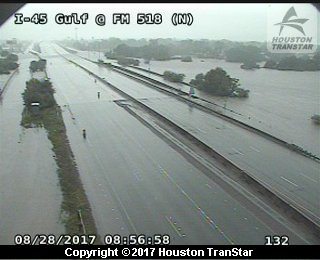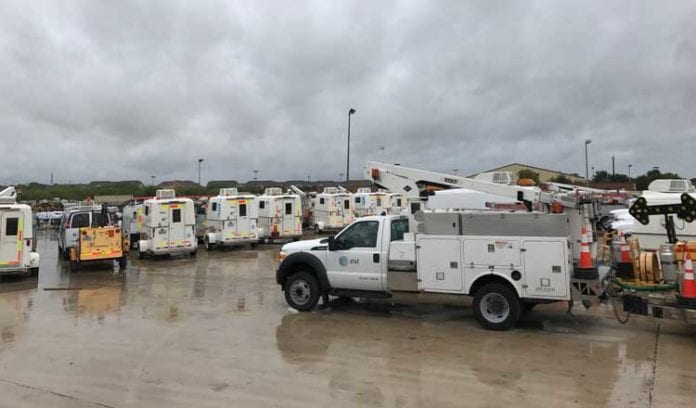Hurricane Harvey leads to massive flooding, power outages; carriers offer free service in impacted areas
As Houston continues to be deluged with rain, the four national wireless carriers are waiving customer fees for voice, data and/or text in the most heavily impacted areas, as they work to keep their networks up and running.
Houston has been hit with more than 20 inches of rain since Thursday night, according to the National Weather Service, which forecasts that an additional 15 to 25 inches will fall on the city through Friday; some areas could see as much as 50 inches total. That flooding means massive power outages in the region, and in many cases commercial crews can’t move into an area to start repairs and service restoration until after flood waters have receded. Hurricane Harvey has devastated a large swath of Texas, with cities such as Rockport, Tex. particularly hard-hit as the storm came ashore.

Carrier efforts in areas impacted by Hurricane Harvey include:
-Through “at least Sept. 1”, AT&T said that it will issue credits to wireless postpaid customers in 30 counties for extra data, voice and text charges, as well as voice and text charges for prepaid customers and will “continue to assess the impact on additional locations in the days ahead.”
AT&T has closed all its stores in Houston, Corpus Christi, Bryan and College Station along with dozens of others across the region. Its Network Disaster Recovery team is staged in San Antonio. AT&T said that its storm preparations included “topping off fuel generators, testing high-capacity back-up batteries at cell sites and protecting physical facilities against flooding” and reported that it has seven satellite cells on light trucks — including one in Bryan, Tex. — there emergency communications vehicles and three charging stations strategically staged around the area.
AT&T also launched a “Severe Weather Mix Channel” on DirecTV dedicated to Hurricane Harvey coverage, replacing one of its sports channels.
“We continue to evaluate the affects from Hurricane Harvey, but overall our networks in South Texas continue to perform well so far,” the carrier told RCR Wireless News in a statement. “In Houston, historic flooding has affected wireline services for some customers, in addition to some wireless and wireline services in the areas around Corpus Christi, Victoria and South Houston that have been affected by power outages and other storm damage. Our technicians are working to restore service to affected areas as quickly and safely as conditions allow. We have also deployed 7 portable cell sites, two charging stations and an emergency communications vehicle in South Texas and additional resources are arriving soon. We are monitoring our network closely and are coordinating with emergency management officials and local utility companies.”
-A Sprint spokesman said in an email that in regards to its Houston network, “a relatively small number of cell sites are impacted due to commercial power outages, but overall the Sprint network in the area affected by Hurricane Harvey is 97% operational. Our crews are out in the field now doing generator deployments and site repairs to get affected sites back on line.”
The carrier is waiving “casual call and text fees fees for Sprint, Boost and Virgin Mobile customers in the impacted areas of Texas and Louisiana” through Sept. 1, and encouraged customers to use text messaging when possible due to network congestion. Sprint stores in the area have also been offering discounts on charging accessories in the lead-up to the storm. Sprint also noted that its Disaster Support Program has been activated. That program lets state and local government agencies request up to 25 mobile devices for free with up to 14 days of service from a declaration of a state of emergency; and the carrier has an additional 10,000 mobile devices for government and non-government organizations who need to rent emergency communications equipment temporarily.
–T-Mobile US told RCR Wireless News in an emailed statement that despite power outages all over Houston, “our towers are holding up well. Less than 5% of the market is affected in terms of service disruption. We’re getting backup generators in place as quickly as it’s safe to do so.”

T-Mobile US said that until Sept. 1, T-Mobile US and MetroPCS customers in fourteen Texas and Louisiana zip codes can call anywhere in the U.S. for free, and reminded its T-Mobile One and Simple Choice customers that they always have unlimited calls and texts.
T-Mobile US is also supporting a “Text to Give” effort in support of the American Red Cross’s Harvey relief efforts. Mobile phone users can text “HARVEY” to 90999 to donate $10; the charge will show up on their next monthly bill.
– Karen Schulz, Verizon spokeperson, said that Verizon’s network in Houston “continues to perform well” and that the carrier is coordinating with federal, state and local agencies on their communications needs. Schulz said that the carrier is also ready to deploy wireless emergency communications centers, which are generator-powered mobile units on tractor trailers that can provide charging capabilities, free internet access and calls.
Schulz said that in flood plain areas where Verizon can anticipate flooding, it builds its equipment on stilts in order to keep it out of the water — although in storm like Harvey, which is bringing unprecedented rainfall to the area, sites are being flooded that typically would not be. She said that the carrier has back-up generators and battery power in all of its switch facilities and its generator refueling vendors on-call, with pre-purchased fuel, “so that we can keep things running without commercial power, because of the flooding. That’s a big issue.”

